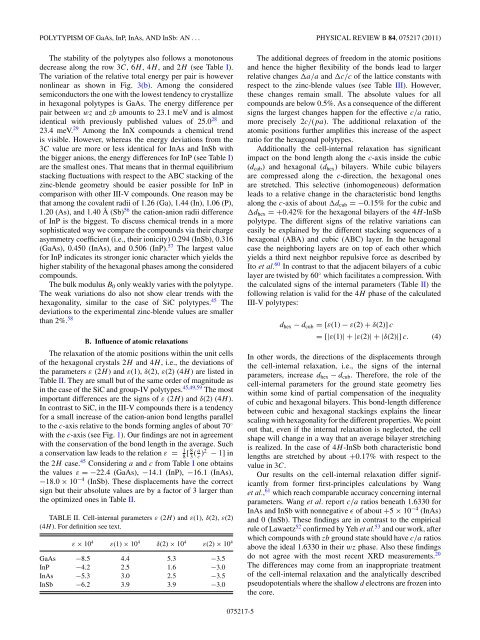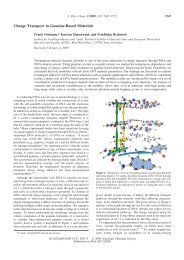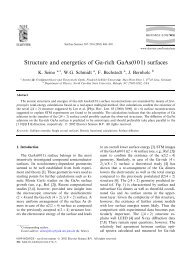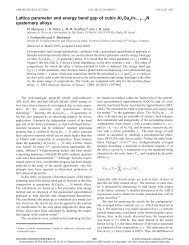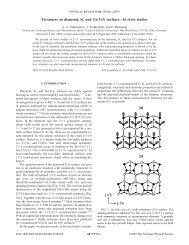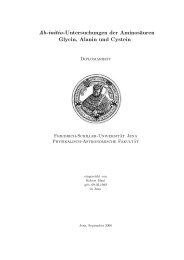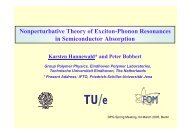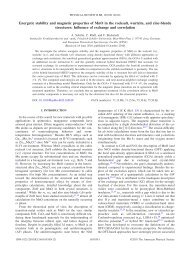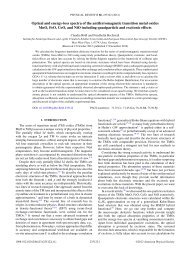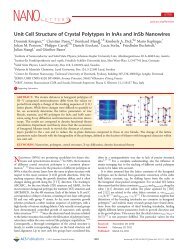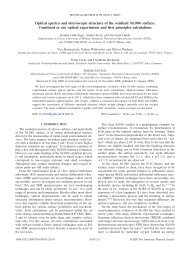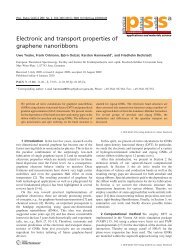Polytypism of GaAs, InP, InAs, and InSb: An ab initio study
Polytypism of GaAs, InP, InAs, and InSb: An ab initio study
Polytypism of GaAs, InP, InAs, and InSb: An ab initio study
You also want an ePaper? Increase the reach of your titles
YUMPU automatically turns print PDFs into web optimized ePapers that Google loves.
POLYTYPISM OF <strong>GaAs</strong>, <strong>InP</strong>, <strong>InAs</strong>, AND <strong>InSb</strong>: AN ... PHYSICAL REVIEW B 84, 075217 (2011)<br />
The st<strong>ab</strong>ility <strong>of</strong> the polytypes also follows a monotonous<br />
decrease along the row 3C, 6H ,4H , <strong>and</strong> 2H (see T<strong>ab</strong>le I).<br />
The variation <strong>of</strong> the relative total energy per pair is however<br />
nonlinear as shown in Fig. 3(b). Among the considered<br />
semiconductors the one with the lowest tendency to crystallize<br />
in hexagonal polytypes is <strong>GaAs</strong>. The energy difference per<br />
pair between wz <strong>and</strong> zb amounts to 23.1 meV <strong>and</strong> is almost<br />
identical with previously published values <strong>of</strong> 25.0 28 <strong>and</strong><br />
23.4 meV. 29 Among the InX compounds a chemical trend<br />
is visible. However, whereas the energy deviations from the<br />
3C value are more or less identical for <strong>InAs</strong> <strong>and</strong> <strong>InSb</strong> with<br />
the bigger anions, the energy differences for <strong>InP</strong> (see T<strong>ab</strong>le I)<br />
are the smallest ones. That means that in thermal equilibrium<br />
stacking fluctuations with respect to the ABC stacking <strong>of</strong> the<br />
zinc-blende geometry should be easier possible for <strong>InP</strong> in<br />
comparison with other III-V compounds. One reason may be<br />
that among the covalent radii <strong>of</strong> 1.26 (Ga), 1.44 (In), 1.06 (P),<br />
1.20 (As), <strong>and</strong> 1.40 Å (Sb) 56 the cation-anion radii difference<br />
<strong>of</strong> <strong>InP</strong> is the biggest. To discuss chemical trends in a more<br />
sophisticated way we compare the compounds via their charge<br />
asymmetry coefficient (i.e., their ionicity) 0.294 (<strong>InSb</strong>), 0.316<br />
(<strong>GaAs</strong>), 0.450 (<strong>InAs</strong>), <strong>and</strong> 0.506 (<strong>InP</strong>). 57 The largest value<br />
for <strong>InP</strong> indicates its stronger ionic character which yields the<br />
higher st<strong>ab</strong>ility <strong>of</strong> the hexagonal phases among the considered<br />
compounds.<br />
The bulk modulus B 0 only weakly varies with the polytype.<br />
The weak variations do also not show clear trends with the<br />
hexagonality, similar to the case <strong>of</strong> SiC polytypes. 45 The<br />
deviations to the experimental zinc-blende values are smaller<br />
than 2%. 58<br />
B. Influence <strong>of</strong> atomic relaxations<br />
The relaxation <strong>of</strong> the atomic positions within the unit cells<br />
<strong>of</strong> the hexagonal crystals 2H <strong>and</strong> 4H , i.e., the deviations <strong>of</strong><br />
the parameters ε (2H ) <strong>and</strong> ε(1), δ(2), ε(2) (4H ) are listed in<br />
T<strong>ab</strong>le II. They are small but <strong>of</strong> the same order <strong>of</strong> magnitude as<br />
in the case <strong>of</strong> the SiC <strong>and</strong> group-IV polytypes. 45,49,59 The most<br />
important differences are the signs <strong>of</strong> ε (2H ) <strong>and</strong> δ(2) (4H ).<br />
In contrast to SiC, in the III-V compounds there is a tendency<br />
for a small increase <strong>of</strong> the cation-anion bond lengths parallel<br />
to the c-axis relative to the bonds forming angles <strong>of</strong> <strong>ab</strong>out 70 ◦<br />
with the c-axis (see Fig. 1). Our findings are not in agreement<br />
with the conservation <strong>of</strong> the bond length in the average. Such<br />
a conservation law leads to the relation ε = 1 8 [ 8 3 ( a c )2 − 1] in<br />
the 2H case. 45 Considering a <strong>and</strong> c from T<strong>ab</strong>le I one obtains<br />
the values ε =−22.4 (<strong>GaAs</strong>), −14.1 (<strong>InP</strong>), −16.1 (<strong>InAs</strong>),<br />
−18.0 × 10 −4 (<strong>InSb</strong>). These displacements have the correct<br />
sign but their <strong>ab</strong>solute values are by a factor <strong>of</strong> 3 larger than<br />
the optimized ones in T<strong>ab</strong>le II.<br />
TABLE II. Cell-internal parameters ε (2H )<strong>and</strong>ε(1), δ(2), ε(2)<br />
(4H ). For def<strong>initio</strong>n see text.<br />
ε × 10 4 ε(1) × 10 4 δ(2) × 10 4 ε(2) × 10 4<br />
<strong>GaAs</strong> −8.5 4.4 5.3 −3.5<br />
<strong>InP</strong> −4.2 2.5 1.6 −3.0<br />
<strong>InAs</strong> −5.3 3.0 2.5 −3.5<br />
<strong>InSb</strong> −6.2 3.9 3.9 −3.0<br />
The additional degrees <strong>of</strong> freedom in the atomic positions<br />
<strong>and</strong> hence the higher flexibility <strong>of</strong> the bonds lead to larger<br />
relative changes a/a <strong>and</strong> c/c <strong>of</strong> the lattice constants with<br />
respect to the zinc-blende values (see T<strong>ab</strong>le III). However,<br />
these changes remain small. The <strong>ab</strong>solute values for all<br />
compounds are below 0.5%. As a consequence <strong>of</strong> the different<br />
signs the largest changes happen for the effective c/a ratio,<br />
more precisely 2c/(pa). The additional relaxation <strong>of</strong> the<br />
atomic positions further amplifies this increase <strong>of</strong> the aspect<br />
ratio for the hexagonal polytypes.<br />
Additionally the cell-internal relaxation has significant<br />
impact on the bond length along the c-axis inside the cubic<br />
(d cub ) <strong>and</strong> hexagonal (d hex ) bilayers. While cubic bilayers<br />
are compressed along the c-direction, the hexagonal ones<br />
are stretched. This selective (inhomogeneous) deformation<br />
leads to a relative change in the characteristic bond lengths<br />
along the c-axis <strong>of</strong> <strong>ab</strong>out d cub =−0.15% for the cubic <strong>and</strong><br />
d hex =+0.42% for the hexagonal bilayers <strong>of</strong> the 4H -<strong>InSb</strong><br />
polytype. The different signs <strong>of</strong> the relative variations can<br />
easily be explained by the different stacking sequences <strong>of</strong> a<br />
hexagonal (ABA) <strong>and</strong> cubic (ABC) layer. In the hexagonal<br />
case the neighboring layers are on top <strong>of</strong> each other which<br />
yields a third next neighbor repulsive force as described by<br />
Ito et al. 60 In contrast to that the adjacent bilayers <strong>of</strong> a cubic<br />
layer are twisted by 60 ◦ which facilitates a compression. With<br />
the calculated signs <strong>of</strong> the internal parameters (T<strong>ab</strong>le II) the<br />
following relation is valid for the 4H phase <strong>of</strong> the calculated<br />
III-V polytypes:<br />
d hex − d cub = [ε(1) − ε(2) + δ(2)] c<br />
= [|ε(1)|+|ε(2)|+|δ(2)|] c. (4)<br />
In other words, the directions <strong>of</strong> the displacements through<br />
the cell-internal relaxation, i.e., the signs <strong>of</strong> the internal<br />
parameters, increase d hex − d cub . Therefore, the role <strong>of</strong> the<br />
cell-internal parameters for the ground state geometry lies<br />
within some kind <strong>of</strong> partial compensation <strong>of</strong> the inequality<br />
<strong>of</strong> cubic <strong>and</strong> hexagonal bilayers. This bond-length difference<br />
between cubic <strong>and</strong> hexagonal stackings explains the linear<br />
scaling with hexagonality for the different properties. We point<br />
out that, even if the internal relaxation is neglected, the cell<br />
shape will change in a way that an average bilayer stretching<br />
is realized. In the case <strong>of</strong> 4H -<strong>InSb</strong> both characteristic bond<br />
lengths are stretched by <strong>ab</strong>out +0.17% with respect to the<br />
value in 3C.<br />
Our results on the cell-internal relaxation differ significantly<br />
from former first-principles calculations by Wang<br />
et al., 61 which reach compar<strong>ab</strong>le accuracy concerning internal<br />
parameters. Wang et al. report c/a ratios beneath 1.6330 for<br />
<strong>InAs</strong> <strong>and</strong> <strong>InSb</strong> with nonnegative ɛ <strong>of</strong> <strong>ab</strong>out +5 × 10 −4 (<strong>InAs</strong>)<br />
<strong>and</strong> 0 (<strong>InSb</strong>). These findings are in contrast to the empirical<br />
rule <strong>of</strong> Lawaetz 52 confirmed by Yeh et al. 53 <strong>and</strong> our work, after<br />
which compounds with zb ground state should have c/a ratios<br />
<strong>ab</strong>ove the ideal 1.6330 in their wz phase. Also these findings<br />
do not agree with the most recent XRD measurements. 20<br />
The differences may come from an inappropriate treatment<br />
<strong>of</strong> the cell-internal relaxation <strong>and</strong> the analytically described<br />
pseudopotentials where the shallow d electrons are frozen into<br />
the core.<br />
075217-5


